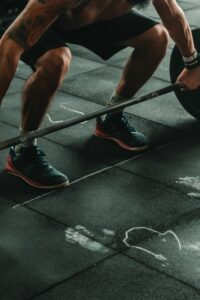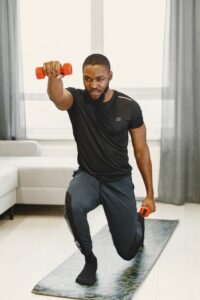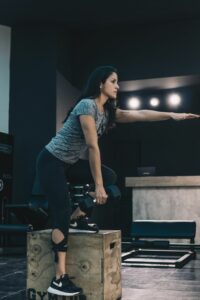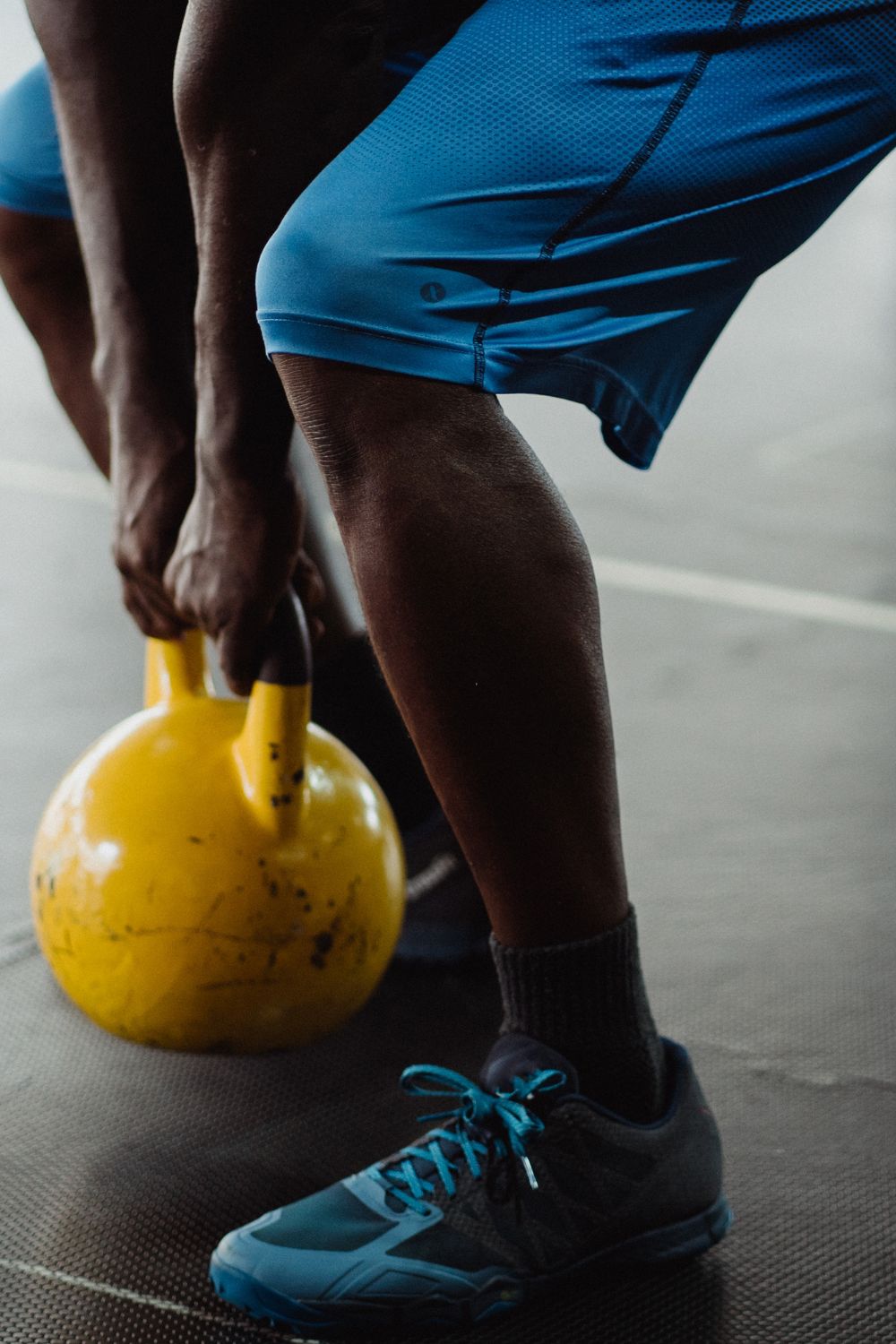Hey there, fitness enthusiasts! If you’re a fan of squats (and who isn’t, considering how effective they are for building lower body strength?), you probably know that they mainly target the quads, hamstrings, and glutes.
But for a truly balanced leg day routine, it’s crucial to complement your squats with other exercises.
In this blog post, we’re going to explore exactly what exercises you should do to offset squats, ensuring that you hit all the right muscle groups and achieve a well-rounded lower body workout.
So, let’s dive right in and discover the perfect exercises to enhance your leg day routine.
Squat Companions: The Key Exercises for a Well-Rounded Leg Workout
To offset squats and create a balanced workout routine, it’s important to target the muscles that squats primarily work, which are the quadriceps, hamstrings, glutes, and lower back.
Here are some exercises you can include in your routine to complement squats:
Deadlifts: Deadlifts are excellent for targeting the hamstrings, glutes, lower back, and overall posterior chain. They provide a great balance to squats, which primarily focus on the front of your legs.
Lunges: Lunges are effective for working the quadriceps, hamstrings, and glutes, similar to squats but with a different range of motion. They also help improve balance and stability.
Leg Press: The leg press machine is another great exercise for the quadriceps, hamstrings, and glutes. It allows you to lift heavy weights and isolate these muscle groups effectively.
Romanian Deadlifts: This variation of the deadlift primarily targets the hamstrings and lower back. It’s excellent for building strength and flexibility in the posterior chain.
Bulgarian Split Squats: These single-leg squats target the quadriceps, glutes, and hamstrings while also improving balance and stability. You can do these with body weight or add weights as you progress.
Glute Bridges: Glute bridges isolate and target the glutes. They are effective for strengthening the posterior muscles and can be done with or without added resistance.
Step-Ups: Step-ups are a great way to work the quadriceps and glutes while also improving balance. You can use a bench or step platform for this exercise.
Box Jumps: Box jumps are a plyometric exercise that can help improve explosiveness and power in your leg muscles. They work the quads, hamstrings, and glutes.
Good Mornings: This exercise primarily targets the lower back and hamstrings. It’s a great way to strengthen the lower back, which is essential for maintaining balance and stability.
Calf Raises: To ensure a well-rounded leg workout, don’t forget about your calves. Standing and seated calf raises can help develop the calf muscles.
Remember to vary your exercises and progressively increase the intensity and weights you use to continue challenging your muscles and promoting growth.
Also, always use proper form to reduce the risk of injury and consult with a fitness professional if you’re new to these exercises or have any medical conditions.
Further explanations here.
Firstly though, let’s dive into more detail about deadlifts and lunges:
Deadlifts:
Deadlifts are a fundamental compound exercise that engages multiple muscle groups and is renowned for its effectiveness in building overall strength and power. Here’s a breakdown of how they work:

Muscles Targeted: Deadlifts primarily target the posterior chain, which includes the hamstrings, glutes, lower back, and even the upper back and traps. They also engage the core muscles.
Execution: To perform a deadlift, you start by standing with your feet hip-width apart, the barbell in front of you. You then bend at the hips and knees to lower yourself down and grip the bar. While keeping your back straight, you lift the bar by extending your hips and standing up. The barbell should travel close to your body during the lift.
Range of Motion: Deadlifts involve lifting a weight from the ground to a fully upright position, which means they work your muscles through a full range of motion.
Benefits: Deadlifts are excellent for building strength and muscle mass in the hamstrings, glutes, and lower back. They also contribute to improved posture and overall stability. Because they recruit so many muscle groups, deadlifts are often considered a foundational exercise for strength training programs.
Lunges:
Lunges are a versatile lower body exercise that adds variety to your leg workout routine. They target the quadriceps, hamstrings, and glutes while also enhancing balance and stability. Here’s a closer look:
Muscles Targeted: Lunges primarily work the quadriceps (front of the thighs), hamstrings (back of the thighs), and glutes. They also engage the calves and core muscles for stabilization.
Execution: To perform a lunge, start by standing with your feet together. Take a step forward with one leg, lowering your body until both knees are bent at approximately 90-degree angles, with your back knee hovering just above the ground. Then, push through the front heel to return to a standing position.

Range of Motion: Lunges involve a dynamic, alternating motion where each leg takes turns moving forward. This helps improve your flexibility and balance, making them a valuable addition to your workout routine.
Benefits: Lunges not only build strength in the quadriceps, hamstrings, and glutes but also enhance balance and coordination. They can help address muscle imbalances between the legs and improve overall lower body stability.
Incorporating both deadlifts and lunges into your workout routine can provide a well-rounded lower body workout, targeting different muscle groups and movement patterns to promote balanced strength and functional fitness.
Let’s explore leg press and Romanian deadlifts in more detail:
Leg Press:
The leg press is a popular machine exercise that primarily targets the muscles of the lower body.
It’s an effective way to build strength in the quadriceps, hamstrings, and glutes. Here’s a closer look at leg press:
Muscles Targeted: The leg press primarily works the quadriceps, which are the muscles at the front of your thighs. It also engages the hamstrings and glutes to a lesser extent. The calf muscles and even some of the muscles in the lower back may also be involved depending on your form and machine design.
Execution: To perform a leg press, you sit in the machine with your feet on a platform. You then push the weight upward by extending your knees and hips until your legs are fully extended but not locked. After that, you lower the weight back down by bending your knees and hips.
Range of Motion: The leg press provides a controlled and stable range of motion, making it a suitable exercise for isolating and strengthening the leg muscles.
Benefits: The leg press is an excellent choice for those looking to target the quadriceps, hamstrings, and glutes while minimizing the involvement of the lower back. It’s also a valuable exercise for individuals who may have mobility or balance issues that limit their ability to perform free-weight squats.
Romanian Deadlifts:
Romanian deadlifts (RDLs) are a variation of the conventional deadlift exercise that places a greater emphasis on the hamstrings and lower back.
They are excellent for building strength and flexibility in the posterior chain. Here’s a closer look:
Muscles Targeted: Romanian deadlifts primarily target the hamstrings and lower back muscles. They also engage the glutes and the muscles of the upper back.
Execution: To perform an RDL, stand with your feet hip-width apart and hold a barbell or dumbbells in front of your thighs.
Keeping your back straight, hinge at your hips while slightly bending your knees. Lower the weight toward the ground while maintaining a slight bend in your knees. Once you feel a stretch in your hamstrings, reverse the movement by extending your hips and returning to a standing position.
Range of Motion: RDLs involve a controlled range of motion focused on the hip hinge movement, allowing you to stretch and strengthen the hamstrings effectively.
Benefits: Romanian deadlifts are exceptional for building strength and flexibility in the hamstrings and lower back. They also contribute to improved hip mobility and can help prevent lower back injuries. RDLs are often used in strength and conditioning programs to complement other leg exercises like squats.
Incorporating both leg press and Romanian deadlifts into your workout routine can provide a well-rounded lower body workout, targeting different aspects of your leg and posterior chain muscles.
Let’s delve into more detail about Bulgarian split squats and glute bridges:
Bulgarian Split Squats:
Bulgarian split squats, also known as rear-foot elevated split squats or simply split squats, are a fantastic lower body exercise that focuses on building strength in the quadriceps, glutes, and hamstrings. They also enhance balance and stability.
Here’s a closer look:
Muscles Targeted: Bulgarian split squats primarily work the quadriceps (front of the thigh), glutes, and hamstrings. Additionally, they engage the calves and various stabilizing muscles throughout the lower body and core.
Execution: To perform a Bulgarian split squat, you’ll need an elevated surface like a bench or step behind you. Stand about two feet in front of the bench and place one foot behind you on the bench. The other foot should be out in front of you.
Lower your body by bending your front knee until it’s at a 90-degree angle or slightly lower, keeping your back knee close to the ground. Push through your front heel to return to a standing position.
Range of Motion: Bulgarian split squats provide a deep range of motion for the front leg while the rear leg stabilizes on an elevated surface. This movement helps improve flexibility and strength in the quadriceps and hamstrings.
Benefits: Bulgarian split squats are excellent for building single-leg strength and addressing muscle imbalances between the legs. They also enhance balance and coordination since they require stability while performing the exercise on one leg.
Glute Bridges:
Glute bridges are a targeted exercise for strengthening the glute muscles, which include the gluteus maximus, medius, and minimus. Here’s a closer look:
Muscles Targeted: Glute bridges isolate and primarily target the glutes. They also engage the lower back, hamstrings, and core muscles to a lesser extent.
Execution: To perform a glute bridge, lie on your back with your knees bent and feet flat on the ground, hip-width apart.
Place your arms by your sides with your palms facing down. Lift your hips off the ground by contracting your glutes and pushing through your heels.
Your body should form a straight line from your shoulders to your knees at the top of the movement. Hold for a moment and then lower your hips back to the ground.
Range of Motion: Glute bridges provide a short but effective range of motion, targeting the glute muscles through hip extension.
Benefits: Glute bridges are an excellent exercise for strengthening the glutes, which play a crucial role in hip stability and overall lower body strength.
They can help improve posture, reduce lower back pain, and enhance athletic performance. Glute bridges can be performed with or without added resistance, such as a barbell or resistance bands, to increase the challenge.
Incorporating Bulgarian split squats and glute bridges into your workout routine can help you build a strong lower body, improve balance, and target specific muscle groups, especially the glutes, for a well-rounded leg and posterior chain workout.
Let’s explore step-ups and box jumps in more detail:
Step-Ups:
Step-ups are a simple yet effective lower body exercise that primarily targets the quadriceps and glutes while also enhancing balance and stability.
Here’s a closer look:
Muscles Targeted: Step-ups primarily work the quadriceps (front of the thigh) and glutes.
They also engage the hamstrings and calf muscles to a lesser extent, as well as the core muscles for stability.
Execution: To perform a step-up, you’ll need a bench, step platform, or sturdy surface. Stand in front of the bench with your feet hip-width apart.

Step onto the bench with one foot, driving through your heel to lift your body up. Ensure your entire foot is on the bench before pushing your body up. Step back down with the same foot, then repeat the movement on the other leg.
Range of Motion: Step-ups involve lifting your body weight by extending your knee and hip joints, which targets the quadriceps and glutes through a controlled range of motion.
Benefits: Step-ups are great for building strength in the quadriceps and glutes, as well as improving balance and coordination. They are a functional exercise that mimics daily activities like climbing stairs.
Box Jumps:
Box jumps are a plyometric exercise designed to enhance explosiveness, power, and agility in the lower body muscles.
Here’s a closer look:
Muscles Targeted: Box jumps primarily work the quadriceps, hamstrings, and glutes. Additionally, they engage the calf muscles, lower back, and core muscles during the explosive jumping movement.
Execution: To perform a box jump, you’ll need a sturdy box or platform of a suitable height. Stand in front of the box with your feet shoulder-width apart. Bend your knees, hinge at your hips, and swing your arms back. Explosively jump onto the box, landing softly with both feet on top. Stand up straight on the box before stepping back down or jumping down (if you’re comfortable with that).
Range of Motion: Box jumps involve a rapid and powerful hip and knee extension, followed by a landing, making them a high-impact plyometric exercise.
Benefits: Box jumps are an excellent choice for developing explosive strength, power, and agility in your lower body. They also improve your ability to generate force quickly, which can be beneficial for sports and activities that require bursts of speed and power.
Both step-ups and box jumps can be integrated into your leg workout routine to target different aspects of lower body strength and power.
While step-ups are more controlled and emphasize stability, box jumps are dynamic and focus on explosive movements. Depending on your fitness goals, you can incorporate one or both exercises to add variety and challenge to your leg workouts.
Let’s delve into more detail about Good Mornings and Calf Raises:
Good Mornings:
Good Mornings are a strength training exercise that primarily targets the lower back and hamstrings.
They are an excellent way to strengthen the lower back, which is essential for maintaining overall balance and stability. Here’s a closer look:
Muscles Targeted: Good Mornings primarily work the lower back (erector spinae muscles) and hamstrings (back of the thighs). They also engage the glutes and the muscles of the upper back to provide support and stability during the movement.
Execution: To perform a Good Morning, start by standing with your feet shoulder-width apart. Place a barbell across your upper back, just below your neck, or hold a pair of dumbbells at your shoulders. Keep your back straight and your knees slightly bent.
Bend forward at the hips, lowering your upper body toward the ground while keeping your back flat. Once you feel a stretch in your hamstrings or when your upper body is parallel to the ground, return to the starting position by extending your hips.
Range of Motion: Good Mornings involve a hip hinge movement that targets the hamstrings and lower back through a full range of motion.
Benefits: Good Mornings are an effective exercise for strengthening the lower back and hamstrings, which is crucial for maintaining good posture and overall lower body stability. They also enhance hip mobility and flexibility.
Calf Raises:
Calf raises are isolation exercises that specifically target the calf muscles (gastrocnemius and soleus). Here’s a closer look:
Muscles Targeted: Calf raises primarily target the calf muscles, which are the muscles at the back of the lower leg. They include the gastrocnemius (the larger, more visible muscle) and the soleus (a deeper muscle).
Execution: To perform calf raises, stand with your feet hip-width apart. You can do these with body weight, holding onto a sturdy surface for balance, or with added resistance using a calf raise machine or dumbbells. Lift your heels off the ground by extending your ankles as high as you can, then lower them back down below your toes.
Range of Motion: Calf raises involve a relatively short range of motion but effectively target the calf muscles through the ankle extension movement.
Benefits: Calf raises help develop and strengthen the calf muscles, which are important for everyday activities like walking, running, and jumping. Strong calf muscles can also improve lower body aesthetics and balance.
Incorporating Good Mornings and Calf Raises into your leg workout routine can provide a well-rounded approach to targeting the lower back, hamstrings, and calf muscles.
These exercises can contribute to improved strength, balance, and stability in your lower body.
A concise tabular on this topic here.
Here’s a concise tabular summary of exercises to offset squats, along with the primary muscle groups they target:
| Exercise | Primary Muscles Targeted | Additional Benefits |
|---|---|---|
| Deadlifts | Hamstrings, Glutes, Lower Back | Overall posterior chain strength |
| Lunges | Quadriceps, Hamstrings, Glutes | Balance, stability, and coordination |
| Leg Press | Quadriceps, Hamstrings, Glutes | Ability to lift heavy weights |
| Romanian Deadlifts | Hamstrings, Lower Back | Strength and flexibility in the posterior chain |
| Bulgarian Split Squats | Quadriceps, Glutes, Hamstrings | Balance, single-leg strength |
| Glute Bridges | Glutes | Posterior muscle strength |
| Step-Ups | Quadriceps, Glutes | Balance and leg strength |
| Box Jumps | Quadriceps, Hamstrings, Glutes | Explosiveness and power in legs |
| Good Mornings | Lower Back, Hamstrings | Lower back strength and flexibility |
| Calf Raises | Calves | Strong and defined calf muscles |
These exercises, when incorporated into your workout routine, can help offset squats by targeting various muscle groups and enhancing overall lower body strength, balance, and stability.
My concise conclusion here: What exercise should you do to offset squats?
In conclusion, to offset squats and create a well-rounded lower body workout, consider incorporating exercises that target different muscle groups.
These exercises include deadlifts, lunges, leg press, Romanian deadlifts, Bulgarian split squats, glute bridges, step-ups, box jumps, good mornings, and calf raises.
By including these exercises in your routine, you can effectively balance and strengthen the various muscles of the lower body, ensuring comprehensive leg development and improved overall stability and performance.

Hey there, it’s Mike Rrsq, the Editor-in-Chief over at Jsquat.com, and I’m absolutely obsessed with all things squat fitness! I’ve been lucky enough to get some serious recognition for my work in this field. With a solid background in the fitness and wellness industry, I’ve been there right from the get-go, helping shape this website into what it is today.
You see, I’m not just the boss around here; I’m also a passionate contributor. I love sharing my insights through my articles, and trust me, they’re not your run-of-the-mill stuff. Each piece I write is a labor of love, filled with my expertise and real-world experience in the fitness universe. So, if you’re into fitness and looking for some inspiration, you’re in the right place!

